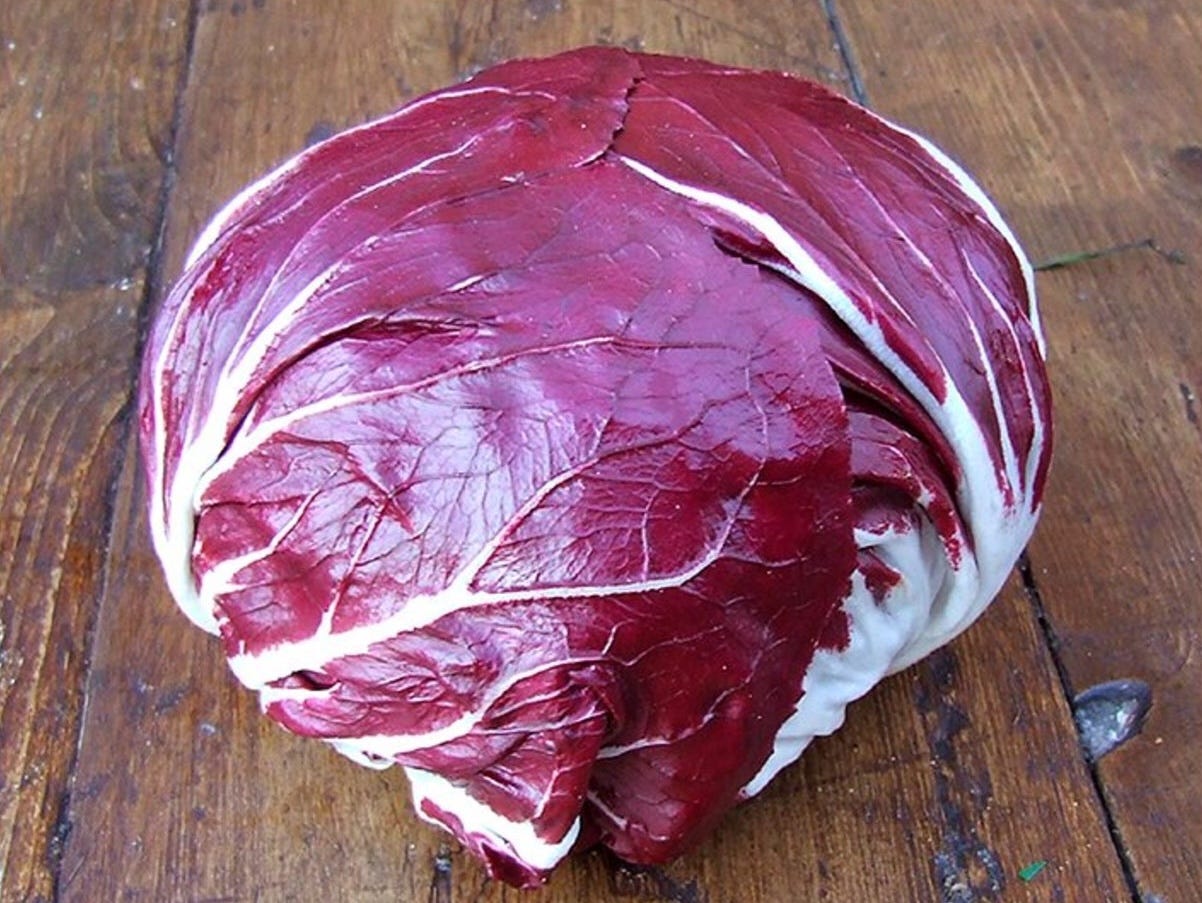A very not-bad dish
This week’s recipe for radicchio, walnut and gorgonzola risotto is a bit diverse, a bit divisive, and a bit great.
Radicchio isn’t to everyone’s taste but is bang in season. You could say the same about rain and we all still live in the UK so, if my maths is correct, if you can live with rain then you can love radicchio.
This week’s album: We Will Always Love You by The Avalanches
This is the third album from an Australian electronic group, and one I came across after Spotify chucked up the group’s song ‘Wherever You Go’ (which Jamie xx produced). The album has so many other great guest features and is sort of easy-listening disco/soul with a real range and mix of original work and sampling.
It’s a bitter-savoury symphony
This week’s risotto will help any radicchio nay-sayers appreciate its unique talents.
Hailing from the north of Italy, radicchio has a bitter-but-wonderfully-savoury taste. Its flavour profile changes and mellows with cooking so we’ll add it to the risotto in two separate stages.
Two other ingredients nominated in this week’s Best Supporting Actor/Actress categories are the creamy gorgonzola (which originates from Milan) and the walnuts. These two will counter the radicchio’s bitterness and help balance the flavour.
Finally, because this dish hails from the north of Italy, we’ll finish things off with plenty of butter and parmesan.
Re the radicchio: there are a number of varieties to choose from but the best come from Chioggia, Verona and Treviso. I’ve used the Chioggia variety (see below) as it’s easy to shred finely. That said, any variety will work.
Side note: I think the Treviso variety is best suited for eating raw, either in a salad or part of crudités with top-quality extra-virgin olive oil.
What you need
The below serves 2. It takes 10 mins to prep and 30 mins to cook.
2 tbsps extra-virgin olive oil
½ red onion (finely diced)
180g risotto rice (carnaroli, arborio, or vialone nano)
75g/ml red wine
1 small head of radicchio (core removed & finely sliced)
750ml good-quality stock (chicken or vegetable)
30g butter (cubed & chilled)
30g parmigiano-reggiano (finely grated)
½ tbsp balsamic vinegar (best quality)
10g chives (finely chopped)
30g butter (cold & cubed)
40g gorgonzola
20g walnuts
Sea salt & black pepper
Ready, steady, cook
1. Preheat your oven to 180°c/160°c fan. When hot, add the walnuts to a baking tray. Drizzle with a small amount of oil and season with a small pinch of salt. Roast in the oven for 6 mins. Set to one side and, when cool, roughly chop.
2. Add the stock to a saucepan. Bring to the boil then reduce to a simmer.
3. Place a heavy-bottomed pan (for cooking the rice) on a medium heat. Add the oil and the diced red onion. Sweat slowly for 6-8 mins, stirring regularly.
4. When the onion is soft and translucent, add the rice and turn the heat up slightly. We want to toast the rice but it’s important not to burn the onion. Stir regularly for about 2 mins, or until the edges of the grains become translucent. Add roughly half of the radicchio and stir through.
5. Pour in the wine - use something you’d be happy to drink the rest of - and stir until it has evaporated. It should come to the boil quickly (taste after 90 seconds to see whether the alcohol has burnt off). Now add a generous pinch of sea salt.
NOTE: adding the salt before the wine can hinder how well the wine is absorbed.
6. Once the wine has evaporated, add a ladle of hot stock to the rice and stir regularly. Add enough to just cover the rice. Once the first ladle of stock has been absorbed, add another and repeat the process.
NOTE I: it’s important to add the stock a little at a time so that we don’t end up just boiling the rice. Doing it like this ‘agitates’ the rice so it releases its starch. This is what makes for the gorgeous creamy texture at the end.
NOTE II: it’s also important to scrape down the sides of the pan with your spatula. This ensures all the rice is cooking together as any grains left on the side would cook a lot more slowly and not be very pleasant if mixed in at the end.
7. Keep stirring as you add the stock. Adjust the temp as needed so that the rice is simmering gently. Your rice should have a creamy texture, and still be al dente, about 16-20 mins after adding the first ladle of stock.
8. You can test grains as you go to see how they change in texture with the cooking. Just make sure you don’t cook the rice for so long that it loses its bite. Check the seasoning levels too and add any salt you need (a lot will depend on how much salt is in your original stock).
9. Add the rest of the radicchio and stir through. Check the consistency, adding extra stock or water to loosen things if necessary. Now remove the pan from the heat. The risotto should be closer to liquidy than firm/stodgy.
10. Add the parmesan, balsamic vinegar and a few twists of freshly ground black pepper. Then rigorously beat/stir the risotto. Lay a tea towel over the pan and leave to rest for two mins. Now add the butter and beat rigorously to incorporate the butter.
NOTE: we do this off the heat so the butter emulsifies into the sauce without splitting. Heating parmesan too much also produces an unpleasant grainy texture.
11. Divide between warmed plates and sprinkle over the toasted walnuts, chopped chives and gorgonzola.
Final thought
If this dish reawakens your relationship with risotto, here are a few more to try: pumpkin, mushroom, sausage, parmigiano-reggiano, Milanese and Barolo. Or you can try something sweet and rice-y.
Speak next week,
Fraser






